What is this mysterious power which is sent out by a tv station and picked up and made into something intelligent by thousands of receivers? What is that which takes place in our atmosphere to which the human body does not respond or can not detect? This mysterious power, which we call radio waves, is actually electromagnetic energy. The word radio is used to indicate it is used for radio communication. The word "waves" means that it radiates outward in a wavelike fashion, as shown in Fig. 1-1.
Since it is electromagnetic, it is related to the common permanent magnet with which we are all acquainted. With all of our vast, accumulated knowledge, very little is known about magnetism. We can't feel it, see it, or hear it, although we can ob serve and measure the effects.
At some time during your life you learned that a horseshoe magnet has a north and a south pole, each at opposite ends of the magnet. A magnetic field is developed around each pole in dependently. Near the magnet, place a loop of wire terminating in a sensitive current-measuring device (galvanometer). Rotate the magnet, and the changing magnetic field will pro duce a current in the wire, first in one direction, then the other (Fig. 1-2). At moderate speeds of rotation ( 3600 revolutions per minute), it would produce 60 complete changes each second, equivalent to the 60-Hz house current in our homes.
Basic ac generators have revolving coils within the magnet structure. Fig. 1-3 is a simplified version of it.
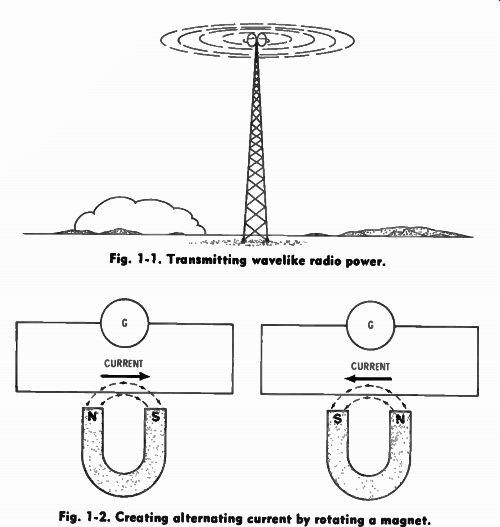
Fig. 1-1. Transmitting wavelike radio power. Fig. 1-2. Creating alternating current
by rotating a magnet.
Disconnect the galvanometer in Fig. 1-2. Connect a ground wire to one end of the lead and an antenna to the other. Now move the magnet fast enough, and the antenna will radiate electromagnetic waves which can travel for thousands of miles.
While the above is an oversimplification, it does illustrate what an electromagnetic wave is. The changes in magnetic polarity are called frequency in radio language. A one million ...
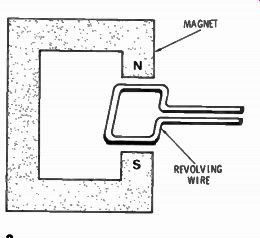
Fig. 1-3. Basic generator ( ac). REVOLVING WIRE
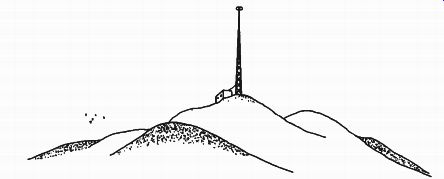
Fig. 1-4. Transmitting tower.
... times per second change is called one million cycles per second, and even more correctly 1 MHz.
Of course a radio or tv station doesn't spin a magnet or a coil to develop their radio signal. They use high-powered tubes and involved circuitry to produce an alternating current in the antenna. The alternating current in the conductors of the antenna produces an alternating electromagnetic force that radiates out to your radio or tv set ( Fig. 1-4) .
RADIO WAVES AND LIGHT WAVES
There are similarities between radio waves and light waves. Although both vary in polarity at a high rate of frequency, light waves involve photons that radiate outward in wavelike fashion. Light waves will pass through glass but are stopped by opaque materials. Radio waves will pass through non metallic substances but are stopped by metal objects or other materials that are electrically conductive. Light may be reflected by a mirror or polished metal. Radio waves are also reflected by conductive materials, and this fact sometimes gives us trouble, especially in the reception of tv signals. Light, as well as radio waves, may be concentrated in one direction by a parabolic reflector. At very high frequencies, called microwave frequencies, antennas are designed somewhat like searchlight reflectors. You have seen them on top of high towers out in the country on high ground, or on top of telephone company buildings ( Fig. 1-5). They are also called "dishpan" antennas, and they increase the power of a radio signal in one direction. They are used to relay tv signals across country and to carry tele phone messages.
There is another similarity between light waves and radio waves. When you turn the channel knob on your tv set, you are selecting circuitry that receives only the frequency produced by
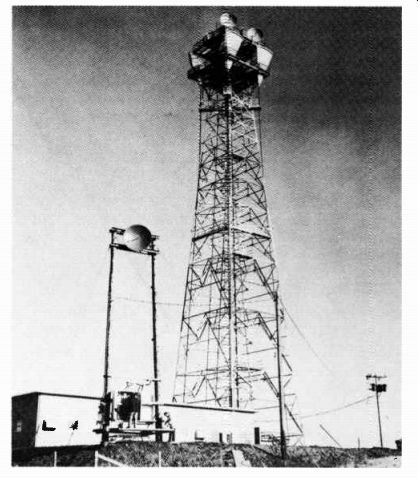
Fig. 1-5. Parabolic reflectors mounted on towers.
... a particular tv station. Television stations, broadcast stations, and other communication stations are assigned a frequency over which they operate. You can pick the one you want to hear. If you could not, you would hear a jumble of all the signals. The different colors of light are also different frequencies.
White light is a combination of all visible light. By placing a colored filter in front of the white light, you would radiate only one color. The colored filters could also act like a tunable receiver, since when you hold a colored filter in front of you, only the color of that filter would be seen from a white-light source.
DIRECT AND REFLECTED WAVES
The effect of large masses of conductive material on radio waves can play havoc on tv signals. The best signal occurs when there is a direct and unobstructed path between the station and your tv set. This is called "line-of-sight" operation ( Fig. 1-6) .
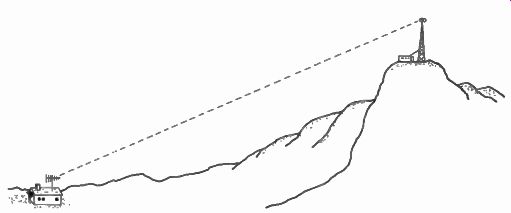
Fig. 1-6. Line-of-sight transmission.
If a large building is in the path, it can reduce the strength of the signal considerably. For this reason, reception inside a large, steel building is often quite poor. The steel in the building acts like a partial shield around your set.
One of the advantages of a reflected signal is in the reception of short-wave stations from great distances. Signals in the 3-MHz to 30-MHz frequency range are reflected or bent by a high ionospheric layer and are reflected back, traveling thou sands of miles and making long distance communication possible ( Fig. 1-7). If it were not for this, the signals would be lost over the horizon. Television signals are too high in frequency to be reflected by the ionosphere, and go right through it. Therefore, tv signals are line-of-sight only, which is why transmitters put their antennas on high buildings or mountain tops. Also, the higher the receiving antenna, the better the received signal.
SHORT WAVE BROADCAST STATION
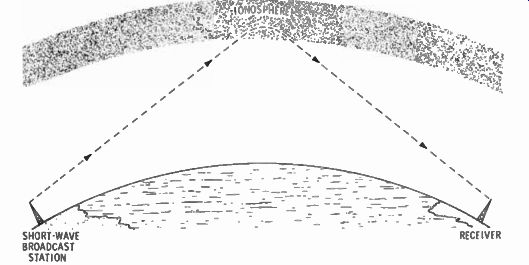
Fig. 1-7. Radio frequencies being reflected by the ionosphere.
WHAT FREQUENCY AND WAVELENGTH MEAN
If you were to drop a stone into a pond of still water, waves would be developed which would move out in ever-widening circles ( Fig. 1-8). If you were to measure the number of wave crests per second that move past a fixed point in the pond, you would be measuring frequency. If you were to measure the distance between crests, you would be measuring wavelength.
The greater the number of wave crests passing a point at a given time, the shorter the distance between crests. Therefore, frequency is inversely proportional to wavelength.
Radio waves work the same way. They move away from the antenna at a fixed speed, 186,000 miles per second or 300,000,000 meters per second. The polarity changes at a high rate. Broadcast stations ( a-m) may transmit a signal frequency anywhere between 535 kHz (535,000 cycles per second) and 1605 kHz ( 1,605,000 cycles per second) depending on the frequency assigned by the Federal Communications Commission.
Many years ago, their frequency was spoken of in terms of wavelength in meters instead of frequency, and some very old sets are still marked in meters. Divide frequency into 300,000,-000 and you get the wavelength in meters. Divide the wavelength in meters into 300,000,000 and you get frequency.
The word meter is still used to describe certain frequency groups or bands. Amateurs will say "75-meter band" for the range of 3.5 to 4.0 MHz, "40-meter band" for the 7.0 to 7.3 MHz range, etc. Those readers interested in the Citizens band around 27 MHz will sometimes hear it expressed as the "11-meter band." The science of tv is more recent, therefore meters never entered the language. Even reference to frequency is reduced to simple channel numbers. It is simpler to think of Channel 4 ...
DISTANCE BETWEEN CRESTS IS THE WAVELENGTH
WAVE MOTION FREQUENCY IS THE NUMBER OF CRESTS PASSING A POINT
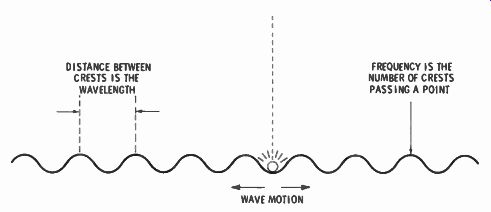
Fig. 1-8. Example of wavelength and frequency.
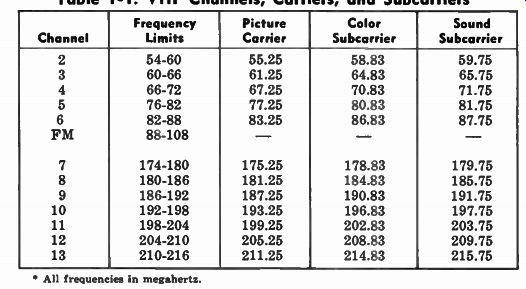
Table 1-1. VHF Channels, Carriers, and Subcarriers
Channel Frequency Limits Picture Carrier Color Subcarrier Sound Subcarrier; • All frequencies in megahertz.
... rather than a 67.25 MHz frequency.
Table 1-1 lists the tv channels and the actual frequencies of the picture signals. Each tv channel also carries a, subcarrier for sound. It is set at just 4.5 MHz higher than the picture carrier frequency. In addition, a color subcarrier is 3.58 MHz higher than the picture-carrier frequency. Uhf tv channels from 14 to 83 are in the frequency range from 470 MHz to 890 MHz.
Broadcast and fm band radio dials have also been simplified.
Most broadcast band receiver dials are marked from 55 to 150. The last digit of the actual frequency in megahertz is dropped off. This is also true of the fm band receiver dials.
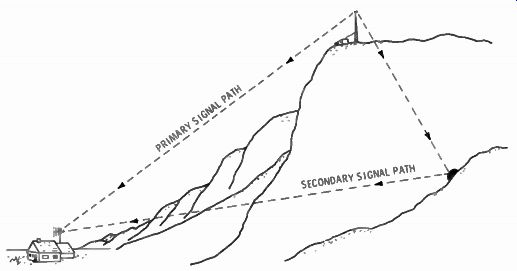
Fig. 1-9. Secondary path can produce ghosts.

Fig. 1-10. Highly directive antenna.
MULTIPATH SIGNALS
There may be a direct path between you and the tv station, but if there is a large mass off to one side ( Fig. 1-9) you may get two signals, one direct and one bounced off the large mass.
Although radio waves travel 186,000 miles per second, there is a slight delay in time between the two signals because of the longer path of the second one, so one signal arrives slightly behind the other. This gives rise to ghosts in your picture- another image slightly to the right of the main image. The large mass may be another high building, a mountain, a water tower, or any other large object that is electrically conductive.
This is the reason for the importance of using highly directive tv antennas at the receiving end ( Fig. 1-10). They reduce, and sometimes even eliminate, the reflected signal. We will discuss this in more detail in a later section.
Sometimes a large building will be in the direct path and a hill produces a secondary path with just as strong a signal, or even stronger. In this case it may even be preferable to point the tv antenna in the direction of the indirect path and eliminate the poorer direct signal. But only a highly directive tv antenna will do this.
Next: WHAT ANTENNAS
Prev: Article Index
AMAZON multi-meters discounts
AMAZON oscilloscope discounts
Also see:
Industrial Electronics (in the early 1960s)
199 Electronic Test & Alignment Techniques (1972)